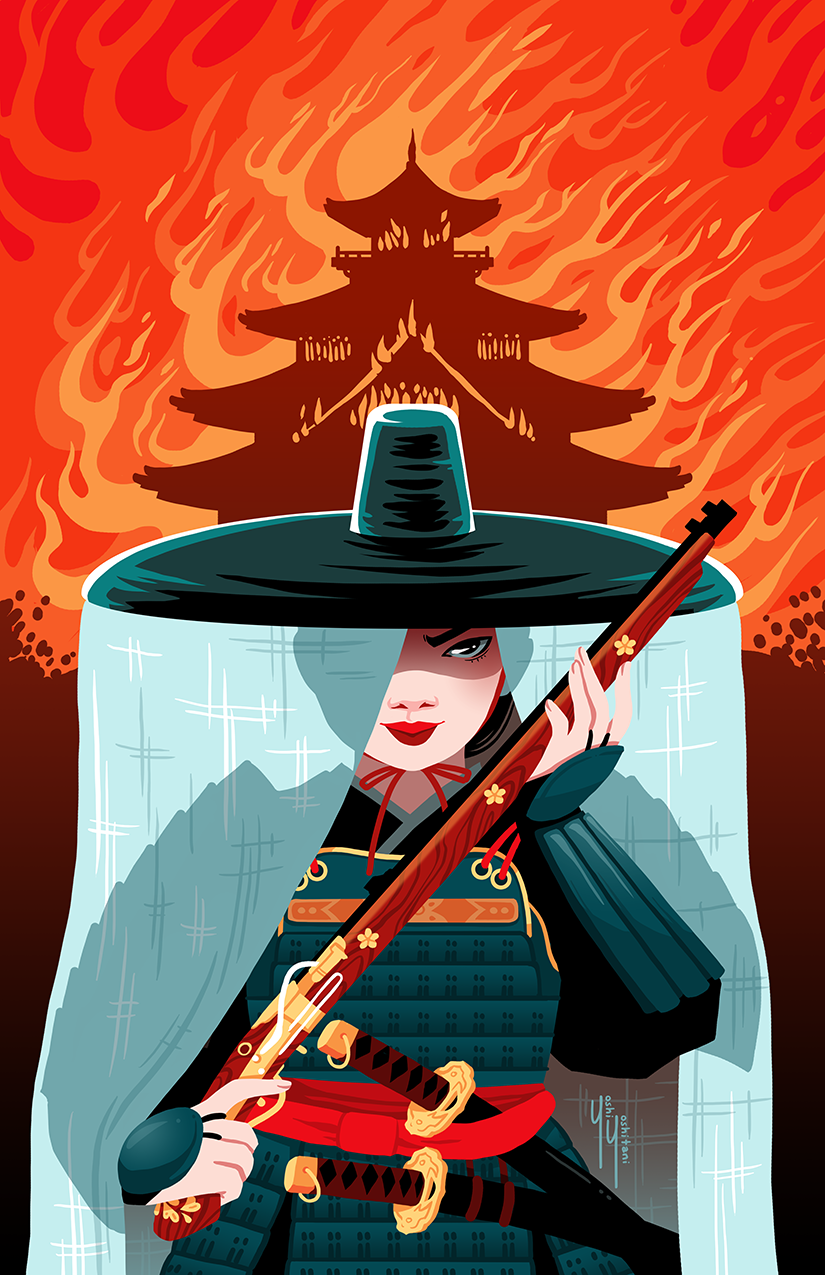Thousand Arrows
Gunpowder and Betrayal!
Thousand Arrows is a tabletop role-playing game of samurai warfare, drama, and tragedy during the Japanese Warring States Period, 1467-1615 CE. You’ll take on the role of a politician, general, spymaster, religious luminary, or revolutionary leader destined to change the course of Japanese history. With hundreds of soldiers at your command, you must forge and break alliances, gather resources, and wage war to secure your vision of a unified Japan.
Yoshi Yoshitani’s cover illustration for Thousand Arrows. An armored samurai wearing a wide-brimmed hat hefts her arquebus and smiles as a castle burns behind her.
What kind of characters can we play?
Every Thousand Arrows character is a leader. They might have a single soldier under their command, a dozen elite spies, a hundred knights, or a thousand foot soldiers. They might represent a revolutionary league of farming communities, a Buddhist denomination, or a samurai clan controlling entire provinces. But whoever they are, their decisions have consequences for all of Japan. Of course, they’re also capable badasses in their own right, able to hold their own in a political negotiation, religious debate, or hand-to-hand combat. However, the deuteragonists and antagonists who populate the world around you are as powerful as you or more: you’ll have to fight and scheme alongside or against the likes of Oda Nobunaga, Ikeda Sen, Uesugi Kenshin, Hattori Hanzō, Francis Xavier, and Yasuke.
Character creation has two principal elements: your allegiance, the team for which you play, and your role, your position on that team. The allegiances include:
Samurai clans: Date, Hōjō, Kukami, Oda, Shimazu, Takeda, Uesugi, or Yagyū
Revolutionary leagues: Iga Provincial League or Single-Minded League
Religions: the Catholic Church, Confucian Academy, or Nichiren School
Outsiders: the Rūchū Kingdom or the knight errant
What about roles? You could play as …
The Courtier, a graceful and shrewd social engineer
The Retainer, the dedicated servant of a feudal liege
The Knight, a heavily armed and armored samurai, aggressive and dangerous
The Foot Soldier, a front-line fighter from the rank and file, resourceful and practical
The Secret Agent, a military intelligence specialist, stealthy and observant
The Warrior Monk, a fanatical Buddhist with more ferocity than doctrine
The Summoner, a practitioner of Daoist and/or Shintō spiritism; or
The Farmer, a tiller of the land caught up in violence, dedicated to their home fields
What do we do in the game?
Since all Japan is at war, the easiest form of Thousand Arrows game is the war narrative. The players join their forces to take on powerful warlords, conduct or repel an invasion, and investigate threats to their alliance from within. However, no war is only about war. Individual ambitions, tempestuous personalities, torrid romances, espionage, and even supernatural mysteries may affect your campaign.
What makes the setting different?
A Thousand Arrows game that matches the course of actual history is neither possible nor particularly desirable, but history is where we start. The Warring States in question are territories controlled by feudal warlords who gather taxes from tenant farmers, raise armies, build fortresses, and struggle with one another to advance their ambitions. The warlords and their clans also
Muskets Everywhere: In the late sixteenth century, samurai armies adopted
Gloria Davis
Maecenas non leo laoreet, condimentum lorem nec, vulputate massa. Donec ac fringilla turpis. Aliquam bibendum, turpis eu mattis iaculis, ex lorem mollis sem, ut sollicitudin risus orci quis tellus.
Bonnie Cho
Donec ac fringilla turpis. Sed a ligula quis sapien lacinia egestas. Aenean eu justo sed elit dignissim aliquam.
Wayne Jenkins
Donec eget risus diam. Nulla lectus ante, consequat et ex eget, feugiat tincidunt metus. Quisque congue porttitor ullamcorper.
